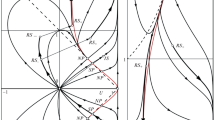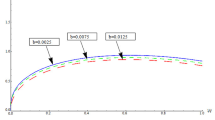Abstract
A plane time-dependent flow generated by the interaction between a normal shock and a low-density gas region occupying a quarter of the plane is theoretically investigated. Numerical simulation is performed on the basis of the Euler equations. It is established that after the shock has come in contact with the low-density region two-dimensional self-similar flows of different type can develop. On regular interaction the original shock is refracted on the low-density region with the matching of the accelerated and original shock and the refracted contact discontinuity at a common point. On irregular interaction a complicated flow occurs; it includes curved and oblique shocks, a contact discontinuity with points of inflection, multiple matching points, a high-pressure jet, and a layered vortex. The jet and vortex structures are investigated in detail. The tendency of the gasdynamic structure development with variation in the control parameters of the problem is determined. A simplified, near-analytical technique for estimating the slopes of the main shocks and the gas parameters behind them is proposed.
Similar content being viewed by others
References
V.I. Artem’ev, V.I. Bergel’son, A.A. Kalmykov, I.V. Nemchinov, T.I. Orlova, V.A. Rybakov, V.A Smirnov, and V.M. Khazins, “Development of a Forerunner in Interaction of a ShockWave with a Layer of Reduced Pressure,” Fluid Dynamics 23(2), 290 (1988).
P.A. Voinovich, A.I. Zhmakin, and A.A. Fursenko, “Modeling the Interaction between ShockWaves in Gases with Spatial Parameter Inhomogeneities,” Zh. Tekhn. Fiz. 58, 1259 (1988).
V.P. Fokeev, Yu.I. Grin, V.A. Levin, Yu.L. Sharov, and Yu.V. Tunik, “The Influence of Gas Discharge on Propagation of Triple-Shock Mach Configuration — Numerical and Experimental Investigations,” in: V.A. Bityurin (ed.), Proc. 5th Intern. Workshop on Magneto-Plasma Aerodynamics in Aerospace Applications, IVTAN, Moscow (2003), p. 234.
P.Yu. Georgievskii and V.A. Levin, “Unsteady Interaction of a Sphere with Atmospheric Temperature Inhomogeneity at Supersonic Speed,” Fluid Dynamics 28(4), 568 (1993).
E. Schulein, A.A. Zheltovodov, E.A. Pimonov, and M.S. Loginov, “Study of the Bow Shock Interaction with Laser-Pulse-Heated Air Bubbles,” AIAA Paper No. 3568 (2009).
P.Yu. Georgievskii and V.A. Levin, “Supersonic Flow past Bodies in the Presence of External Heat Sources,” Pisma Zhurn. Tekhn. Fiz. 14, 684 (1988).
S.V. Guvernyuk and K.G. Savinov, “Isobaric Separation Structures in Supersonic Flows with Localized Inhomogeneities,” Dokl. Ross. Akad. Nauk 413, 188 (2007).
V.I. Artem’ev, V.I. Bergel’son, I.V. Nemchinov, T.I. Orlova, V.A Smirnov, and V.M. Khazins, “Change of Regime in Supersonic Flow past an Obstacle Preceded by a Thin Channel of Reduced Density,” Fluid Dynamics 24(5), 779 (1989).
P.Yu. Georgievskii and V.A. Levin, “The Concept of Controlling Flow past Bodies Using a Weak Energy Action on the Oncoming Stream,” in: V.M. Fomin (ed.) Methods of Aerophysical Investigation. Proc. of the Intern. ICMAR Conf. 2004. Part V [in Russian], Nonparel, Novosibirsk (2004), p. 42.
O.A. Azarova and Yu.F. Kolesnichenko, “On Details of Flow Structure during the Interaction of an Infinite Rarefied Channel with a Cylinder Shock Layer,” in: V.A. Bityurin (ed.), Proc. 5th Intern. Workshop on Magneto-Plasma Aerodynamics in Aerospace Applications, IVTAN, Moscow (2003), p. 101.
R.W. McCormack, “The Effect of Viscosity in Hypervelocity Impact Cratering,” AIAA Paper No. 354 (1969).
A.I. Zhmakin, F.D. Popov, and A.A. Fursenko, “Smoothing Method in Calculating Discontinuous Gas Flows,” in: Algorithms and Software for Physical Problems. Vol. 2 [in Russian], USSR Academy of Sciences, Physical and Technical Institute, Leningrad (1977), p. 65.
B. Edney, “Anomalous Heat Transfer and Pressure Distributions on Blunt Bodies at Hypersonic Speeds in the Presence of an Impinging Shock,” Aeronaut. Res. Inst. of Sweden, FTA Report 115 (1968).
Additional information
Original Russian Text © P.Yu. Georgievskii, V.A. Levin, O.G. Sutyrin, 2010, published in Izvestiya Rossiiskoi Akademii Nauk, Mekhanika Zhidkosti i Gaza, 2010, Vol. 45, No. 2, pp. 126–134.
Rights and permissions
About this article
Cite this article
Georgievskii, P.Y., Levin, V.A. & Sutyrin, O.G. Two-dimensional self-similar flows generated by the interaction between a shock and low-density gas regions. Fluid Dyn 45, 281–288 (2010). https://doi.org/10.1134/S0015462810020134
Received:
Published:
Issue Date:
DOI: https://doi.org/10.1134/S0015462810020134




